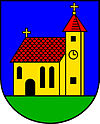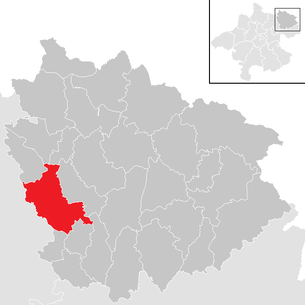Neumarkt in the Mühlkreis
|
market community Neumarkt in the Mühlkreis
|
||
|---|---|---|
| coat of arms | Austria map | |
|
|
||
| Basic data | ||
| Country: | Austria | |
| State : | Upper Austria | |
| Political District : | Free City | |
| License plate : | FR | |
| Surface: | 46.67 km² | |
| Coordinates : | 48 ° 26 ' N , 14 ° 29' E | |
| Height : | 632 m above sea level A. | |
| Residents : | 3,173 (January 1, 2020) | |
| Population density : | 68 inhabitants per km² | |
| Postal code : | 4212 | |
| Area code : | 07941 | |
| Community code : | 4 06 12 | |
| NUTS region | AT313 | |
| Address of the municipal administration: |
Marktplatz 1 4212 Neumarkt im Mühlkreis |
|
| Website: | ||
| politics | ||
| Mayor : | Christian Denkmaier ( SPÖ ) | |
|
Municipal Council : (2015) (25 members) |
||
| Location of Neumarkt im Mühlkreis in the Freistadt district | ||
 Place view |
||
| Source: Municipal data from Statistics Austria | ||
Neumarkt im Mühlkreis is a market town in Upper Austria in the district of Freistadt in Mühlviertel with 3173 inhabitants (as of January 1, 2020). The community is located in the judicial district of Freistadt .
geography
Neumarkt im Mühlkreis is located at an altitude of 632 m in the Mühlviertel. The extension is from north to south 10.5 km and from west to east 10.5 km. The total area is 46.8 km². 15.5% of the area is forested and 28.9% of the area is used for agriculture.
Community structure
The municipality includes the following 26 localities (population in brackets as of January 1, 2020):
|
|
The community consists of the cadastral communities Matzelsdorf, Neumarkt im Mühlkreis, Trosselsdorf and Zeiß.
Neighboring communities
| Hirschbach | Forest castle | Free City |
|
Ottenschlag Alberndorf |

|
Kefermarkt |
| Unterweitersdorf | Hagenberg | Pregarten |
history
Neumarkt was probably built around 1100. The reason for this is the Neumarkter Berg, which represented an obstacle for the salt and trade wagons between Bohemia and the Upper Austrian Salzkammergut . Horses had to be provided as a leader to pull up the wagons. Once at the top, the horses and coachmen had to freak out. In 1171 Neumarkt was first mentioned in a document as "novum forum" (Latin for new market ). Duke Heinrich of Austria promised in a document to protect the area around Neumarkt im Mühlkreis from enemies.
Rest areas and stables were built where previously there was only forest. Over the next few centuries the number of houses grew to 30, some of which were built along the trade route and some around the church . Since up to 100 salt carts required a break and a break on different days, there were soon many restaurants, bowling alleys and shooting ranges.
Since 1490 it has been assigned to the principality ' Austria ob der Enns '. In 1500, Emperor Maximilian made the town a market. Neumarkt got free market and trade.
In 1609 a big market fire shook the place: 22 wooden houses with wooden shingles, as well as numerous documents were destroyed in the flames.
During the Napoleonic Wars , the place was occupied several times. Since 1918 the place belongs to the federal state of Upper Austria . After Austria was annexed to the German Reich on March 13, 1938, the place belonged to the "Gau Oberdonau". After 1945 Neumarkt was in the Soviet occupation zone and after 1955 the infrastructure was built up and rebuilt. In 2003, the Neumarkt tunnel was opened and through-traffic was banned from the town center.
population
| Population development | ||||
|---|---|---|---|---|
| year | Residents | year | Residents | |
| 1869 | 2,229 | 1951 | 2,317 | |
| 1880 | 2,275 | 1961 | 2,359 | |
| 1890 | 2,290 | 1971 | 2,485 | |
| 1900 | 2.233 | 1981 | 2,539 | |
| 1910 | 2,326 | 1991 | 2,743 | |
| 1923 | 2,428 | 2001 | 3,071 | |
| 1934 | 2,425 | 2011 | 3,078 | |
| 1939 | 2,309 | 2018 | 3.163 | |
Development and structure
In 1869, 2229 people lived in the municipality. Until 1961 the population grew little. The population has been growing rapidly since 1961, and in 2001 it reached 3,071 people, the highest level ever in a census. In 1991 the community had 2,743 inhabitants, in the 2001 census it had already 3,071, which corresponds to an increase of 12%. On January 1st, 2008 the community had 3,080 inhabitants.
In the 2001 census, the proportion of residents aged 60 and over was 16.8%; 21% were under 15 years old. The proportion of the female population was 50.6%.
Of the 2,427 residents of Neumarkt, who were over 15 years old in 2001, 4.3% had completed a university , technical college or academy . A further 9.3% had completed a Matura , 48.7% had completed an apprenticeship or a vocational middle school and 37.7% of all Neumarkters had compulsory school as the highest degree.
Origin and language
The German dialect that is commonly spoken in the Neumarkt area and in Upper Austria is Middle Bavarian . In 2001, 98.6% of Neumarkt residents stated that German was their everyday language. Another 0.2% spoke mainly Croatian , 0.1% Serbian , the rest spoke other languages.
The proportion of people from Neumarkt with foreign citizenship was 1.5% in 2001, well below the average in Upper Austria. 0.4% of the Neumarkt population had citizenship from Germany and 1.1% were other citizens. In 2001, around 2.3% of Neumarkt residents were born in a country other than Austria.
politics
The municipal council and mayoral elections take place every six years, at the same time as the state elections. From 1945 to 2003 the ÖVP always achieved the majority, until 1997 always the absolute. The second strongest party was always the SPÖ . The FPÖ became the third strongest party in the elections. In 2003 the ÖVP became the party with the strongest vote with 45.7%, but the SPÖ provides the mayor. In the 2009 elections, the SPÖ became the party with the strongest vote for the first time with 45.2% of the votes.
The 2015 municipal council election, with a turnout of 89.6%, produced the following results:
| Party / political grouping | voting share |
Verän- alteration |
Seats on the local council |
Verän- alteration |
|---|---|---|---|---|
| ÖVP | 32.2% | -10.2% | 8th | -3 |
| SPÖ | 39.6% | -5.6% | 10 | -1 |
| FPÖ | 14.9% | + 6.4% | 4th | +2 |
| GREEN | 13.3% | 13.3% | 3 | +3 |
Mayor of the municipality is Christian Denkmaier from the SPÖ. The municipal council consists of 25 members.
coat of arms
The municipal coat of arms shows in blue on a green shield base a golden, red covered and black opened church with a clock on the tower and a golden cross each on the roof of the ship and the tent roof of the tower on the left. The church is the Neumarkt parish church, which can be traced back to 1185.
The award of the municipal coat of arms and the municipal colors is not known. In 1613 the coat of arms was confirmed again after the old documents burned in 1609 . The design of the current coat of arms dates from 1948 and is a simplified representation of the seal from the 17th century with inscription. S. AT THE . NEWMARCKHT.
Culture and sights
Horse train
The route of the horse-drawn railway Budweis – Linz – Gmunden ran along the Kleine Gusen from 1832 to 1872 through the municipality of Neumarkt im Mühlkreis. Some buildings, bridges and threshold stones of the horse-drawn railway are still preserved. Today the horse-drawn railway trail leads along the route .
Buildings
- Parish church Neumarkt: first mentioned in 1185
- Kronest Castle Ruins : A castle built in 1334 that has been uninhabited since 1609 and is now a ruin in the Kronest district.
- Burgstall Kammermaier : Burgstall on the Kammermaierberg in Trölsberg.
- Castle ruin Möstling : A castle in Matzelsdorf that has fallen into ruin since 1499.
- Marterln, cross sticks and chapels: can be found throughout the municipality
Museums
- Most museum: implements the historic cider production in stoabloßen Presshaus
music
- Musikverein Neumarkt (with around 50 members)
- Church choir & youth choir Neumarkt
- music school
Sports
- ASKÖ Neumarkt
- Sportunion Neumarkt
- Kronast tennis club
- URFV Neumarkt
Economy and Infrastructure
There is the Nah und Frisch supermarket in Neumarkt, which takes on the tasks of the post office and the tobacco shop. There is also a savings bank and a Raiffeisen bank branch.
traffic
The Mühlviertler Schnellstraße (S 10) runs through a tunnel below the town . The Neumarkt tunnel was opened in 2003 and through traffic through Neumarkt stopped.
Public institutions and education
A kindergarten , a primary school , a new middle school and a music school are available in the village . There is also a library and an outdoor swimming pool . There are also two general practitioners in the community.
There are six volunteer fire brigades in the municipality : Neumarkt, Dingdorf, Lamm, Matzelsdorf, Trosselsdorf and Zeiß.
Parish partnership
Horneburg in the German state of Lower Saxony near Hamburg is Neumarkt's partner municipality.
Personalities
- Josef Mühlbachler (* 1945): Mayor of the city of Freistadt and member of the National Council
- Bert Brandstetter : journalist, psychologist, choir director and singer; Consultant to the Upper Austrian provincial government, President of KA OÖ
- Karl Aichhorn (musician) (* 1964): musician, conductor, composer and educator
literature
- Historical bibliography in the forum OoeGeschichte.at
Web links
- Cider Museum
- Website of the market town of Neumarkt im Mühlkreis
- 40612 - Neumarkt in the Mühlkreis. Community data, Statistics Austria .
- More information about the municipality of Neumarkt im Mühlkreis on the geographic information system of the federal state of Upper Austria .
Individual evidence
- ↑ Statistics Austria: Population on January 1st, 2020 by locality (area status on January 1st, 2020) , ( CSV )
- ↑ a b Statistics Austria: Population and components of population development (download as pdf; 34 kB)
- ↑ a b c 2001 census: demographic data (download as pdf; 10 kB)
- ↑ Municipal elections percentages: Municipal elections Neumarkt ( page no longer available , search in web archives ) Info: The link was automatically marked as defective. Please check the link according to the instructions and then remove this notice. (accessed on October 28, 2008)
- ↑ http://wahl.land-oberoesterreich.gv.at/whlp/WHLPErgebnisEingelangtNEU.jsp?BezirksListe=6&GemeindeListe=40612&cmdAktualisieren=&bezirkAlt=6&wahlKreisAlt=&wahlNameKurz=G09&gemeindeNummerLink= ( page no longer available , searching web archives ) Info: The link was automatically marked as defective. Please check the link according to the instructions and then remove this notice.
- ↑ a b Province of Upper Austria, results of the 2015 elections. Accessed on May 13, 2019 .
- ^ Province of Upper Austria, regional history: coat of arms of the municipality of Neumarkt (accessed on October 28, 2008)
- ^ Municipality of Neumarkt im Mühlkreis, schools. Retrieved May 13, 2019 .
- ^ Municipality of Neumarkt im Mühlkreis, partner municipality. Retrieved May 19, 2019 .






